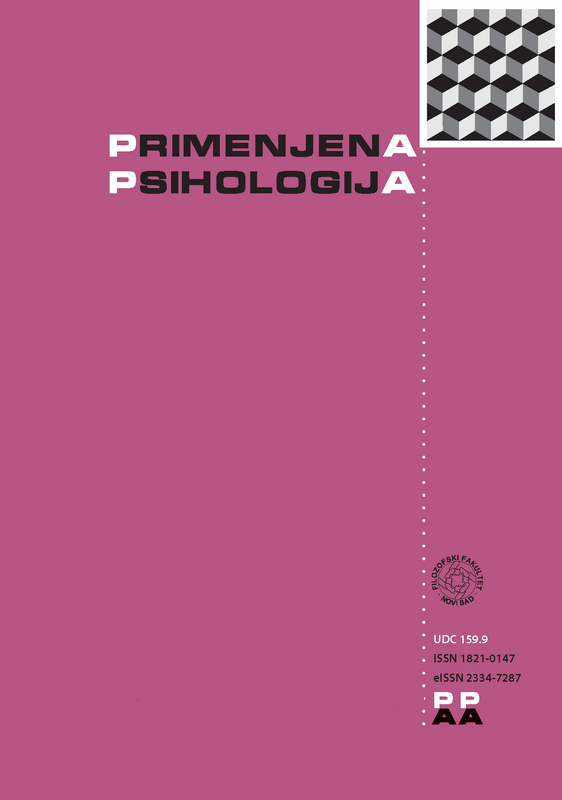VISUAL DETECTION OF STATIC OBJECTS AMONG DYNAMIC DISTRACTORS
DOI:
https://doi.org/10.19090/pp.2016.1.101-118Keywords:
visual search, movement, jitter, luminace changeAbstract
Though a dynamic object, placed against stationary background, always grabs attention, opposite is not necessarily true. Hence, in this study we placed a stationary target among the dynamic distractors. We investigated whether visual detection depends on (1) set size (9, 18 or 27), (2) type of the distractor dynamics (jitter, blink, or luminance change) and (3) synchronisation (synchronized or unsynchronized distractors change). In contrast to pop-out effect of a dynamic target, the search for stationary target was serial, as the RT analysis revealed. The synchronisation of the distractor dynamic properties helped the detection especially in the larger sets. The most distracting for the target detection was illumination change of the distractors whereas the least distracting was blink.References
Alais, D., Blake, R., & Lee, S. H. (1998). Visual features that vary together over time group together over space. Nature Neuroscience, 1, 160‒164. doi:10.1038/414
Davis, G., & Leow, M. C. (2005). Blindness for unchanging targets in the absence of motion filtering a response to Theeuwes (2004). Psychological Science, 16, 80‒82. doi:10.1111/j.0956-7976.2005.00784.x
Duncan, J., & Humphreys, G. W. (1989). Visual search and stimulus similarity. Psychological Review, 96, 433‒458. doi:10.1037/0033-295X.96.3.433
Found, A., & Muller, H. J. (1995). Searching for unknown feature targets on more than one dimension: Further evidence for a ‘dimension weighting’ account. Perception and Psychophysics, 58, 88‒101. doi:10.3758/BF03205479
Jiang, Y., Chun, M. M., & Marks, L. E. (2002). Visual marking: Selective attention toasynchronous temporal groups. Journal of Experimental Psychology: Human Perception and Performance, 28, 717‒730. doi:10.1037/0096-1523.28.3.717
Johansson, G. (1973). Visual perception of biological motion and a model for its analysis. Attention, Perception, & Psychophysics, 14, 201‒211. doi:10.3758/BF03212378
Lee, S. H., & Blake, R. (1999). Visual form created solely from temporal structure. Science, 284(5417), 1165‒1168. doi:10.1126/science.284.5417.1165
Mandler, M. B. (1984). Temporal frequency discrimination above treshold. Vision Research, 24, 1873‒1880. doi:10.1016/0042-6989(84)90020-8
McLeod, P., Driver, J., & Crisp, J. (1988). Visual search for a conjunction of movement and form is parallel. Nature, 332, 154‒155. doi:10.1038/332154a0
McLeod, P., Driver, J., Dienes, Z., & Crisp, J. (1991). Filtering by movement in visual search. Journal of Experimental Psychology: Human Perception & Performance, 17, 55‒64. doi:10.1037/0096-1523.17.1.55
Pashler, H. (2001). Involuntary orienting to flashing distractors in delayed search?. In C. L. Folk & B. Gibson (Eds.), Attraction, distraction, and action: Multiple perspectives on attentional capture (pp. 77‒92). New York: Elsevier. doi:10.1016/S0166-4115(01)80006-6
Pinto, Y., Olivers, C. N. L., & Theeuwes, J. (2006). When is search for a static target among dynamic distractors efficient? Journal of Experimental Psychology: Human Perception and Performance, 32, 59‒72. doi:10.1037/0096- 1523.32.1.59
Sekuler, A. B., & Bennett, P. J. (2001). Generalized common fate: Grouping by common luminance changes. Psychological Science, 12, 437–444. doi:/10.1111/1467-9280.00382
Theeuwes, J. (2004). No blindness for things that do not change. Psychological Science, 15, 65‒70. doi:10.1111/j.0963-7214.2004.01501011.x
Treisman, A. M., & Gelade, G. (1980). A feature-integration theory of attention. Cognitive psychology, 12(1), 97–136.
Uttal, W. R., Spillmann, L., Stürzel, F., & Sekuler, A. B. (2000). Motion and shape in common fate. Vision Research, 40, 301‒310. doi:10.1016/S0042- 6989(99)00177-7
Wertheimer, M. (1938). Laws of organization in perceptual forms. In W. D. Ellis (Ed.), A source book of Gestalt psychology (pp. 71–94). London, England: Routledge & Kegan Paul.
Wolfe, J. M. (2003). Moving towards solutions to some enduring controversies in visual search. Trends in Cognitive Sciences, 7, 70–76. doi:10.1016/S1364- 6613(02)00024-4
Yantis, S., & Hillstrom, A. P. (1994). Stimulus-driven attentional capture: evidence from equiluminant visual objects. Journal of Experimental Psychology: Human Perception and Performance, 20, 95‒107. doi:10.1037/0096-1523.20.1.95







